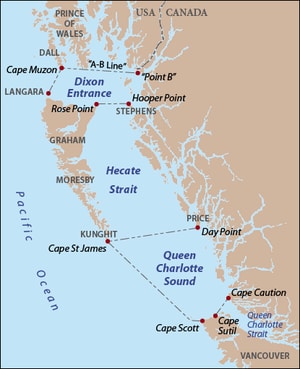With the Seymour Narrows transit being around 1 am. in the morning, it unfortunately means that the majority of the voyage through the Inside Passage is during the darker hours. At least the part where it is narrower. By the time most of our guests awaken we have just passed Pine Island and enter Queen Charlotte Sound. Although it is inland waters, the Sound is more than 25 miles wide at places, and when there you can just see the Canadian Mainland to the East and the Queen Charlotte Islands to the West. In summer time it is nice sailing and often a lot of wild life to be seen as long as you take the time to look for it. In the winter time is this is a very nasty place. You might think as it is enclosed at all sides, it would not be as bad as the North Pacific Ocean itself but in some aspects it can be worse. Much worse.
The Sound is practically North to South orientated and then continues up north into Hecate Strait which ends up in Dixon Entrance. This separation zone between Canada and the USA runs East to West. So all the bad weather from the North Pacific can roll straight in. If the bad weather is coming from the South then it blows directly into the Sound and up to Hecate Strait. So whatever the bad weather is, it can find a nice place in Queen Charlotte Sound to play around in. Even if the bad weather comes from the East, from the Mainland, then the surface area is big enough for an Easterly wind to whip up the waves and those waves have nowhere to go as to the West there are the islands. Roller Coaster Times.

Over view of the Queen Charlotte Sound. (Courtesy of Wikipedia) In the old days we could slip inside just North of Cape Caution, now it is just passed Day Point for most ships.
The other challenge with this area is, is that the Sound is not very deep and the open area open enough to have the wind whip up sufficient high waves. When waves are created by the wind, they have to carry the wind energy somewhere in one way or the other. In the ocean that results in long and high waves of great length. They can be nasty but normally the ship can ride them by adjusting speed and going into a sort of surfing mode. Our Prinsendam is a ship which has a perfect length for that and is therefore a very good sea ship and is much less affected by bad weather than other- larger- vessels.
On shallow water things change. The waves have nowhere to put the energy as no long rolling waves can be created. A wave has a part that goes up and a part that goes down. On shallow water the wave cannot go down, only up. This results in shorter and sharper waves which are very difficult to ride. The ship almost at once starts pitching (slamming of the bow on the waves) and it becomes very uncomfortable for those on board and it can become very dangerous for the ship itself. Many a captain who decided to go in the open during the winter time was caught by an un-expected storm and lost his ship. Either the ship took on too much water or the wooden hull cracked due to slamming onto the waves.
So in the winter the only option is, to stay all the way inside. That is possible but it size dependent. The regular steamer route which we follow takes us part outside and part inside. Depending on the time available a few variations are possible. To stay completely inside is depending on the size as there are a few locations where the turns are very tight and you cannot see what is coming from the other side. Well known for this are Hiekish Narrows and Boat-bluff. When we still had our previous Prinsendam (1973 / 9000 tons) it was possible to stay “behind the mountains” all the way. Later with our Statendam IV of 25000 tons, we had to forego one area and with the arrival of the Rotterdam V of 38.000 tons we had to forego another route. Now the ships are all 55000 tons and over and although the ships offer a lot more inside the ship, we are a bit limited for where we can go to show things outside the ship.
Still, there is lot’s to see. I was cooped up inside the ship all day for trainings and inspections but the one moment I stepped outside I saw both a Minke Whale and a group of small porpoises quite nearby.
Tomorrow we are in Ketchikan and it looks like a real Ketchikan day. 11oC / 51oF. and 90% chance of rain and drizzle, plus a cold wind blowing. But the wind is supposed to be from the S.E so maybe the mountains will provide some shelter. There will be three ships inn port but we will have the best dock with the shortest walking distance into town. (Basically ——- Cross the road and you are there)

July 12, 2017 at 4:09 pm
Can the current Prinsendam not sail along ‘behind the mountains’ part of the way?
July 13, 2017 at 10:52 am
Good morning,
thank you for reading my blog.
She could but even with just being over 33,000 tons the pilots are not that excited about
going through Boat Bluff and related, mainly due to opposing traffic which might be coming from behind the mountain range and do not announce themselves.
Best regards
Capt. Albert